Support Center.
Get Started or Become a Pro. Browse our support articles to learn how to get the best out of PeopleGoal.
How to set up a SMART Goals template
Without having any goals set it's impossible to hit the target. In any team or organization there must be a clear and well-defined objective for employees to work towards. Through creating SMART Goals, any leader can easily guide their team to success. The acronym SMART stands for Specific, Measurable, Attainable, Relevant and Time-bound. Essentially, through the SMART Goals template, you will be able to set realistic objectives with precise instructions.
PeopleGoal streamlines the process of setting goals, breaking down any type of goal from complex organization-wide objectives to individual milestones. The app template is ready for use from the second you install it, or you have the freedom to customize it according to any of your needs using our simple, no-code workflow builder.
Following the steps below, you'll be able to install and set up SMART Goals in the blink of an eye:
1. Install your SMART Goals template
2. Customize the SMART Goals app template (optional)
3. Connect to your team/organization objectives
Now let's get stuck in.
1. Install your SMART Goals Template
- From your dashboard click Workspaces on the lefthand menu.
- Open up any workspace and click Create a new app.
- Select Store template and search for SMART Goals.
- Click Add this to your account and we'll do the rest.

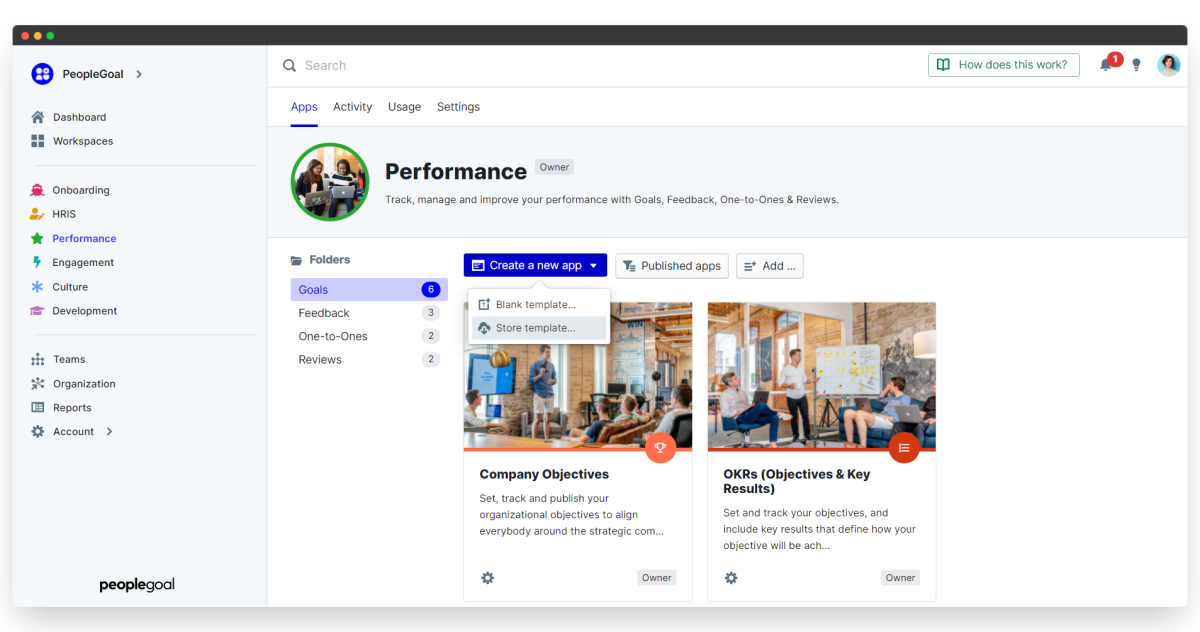
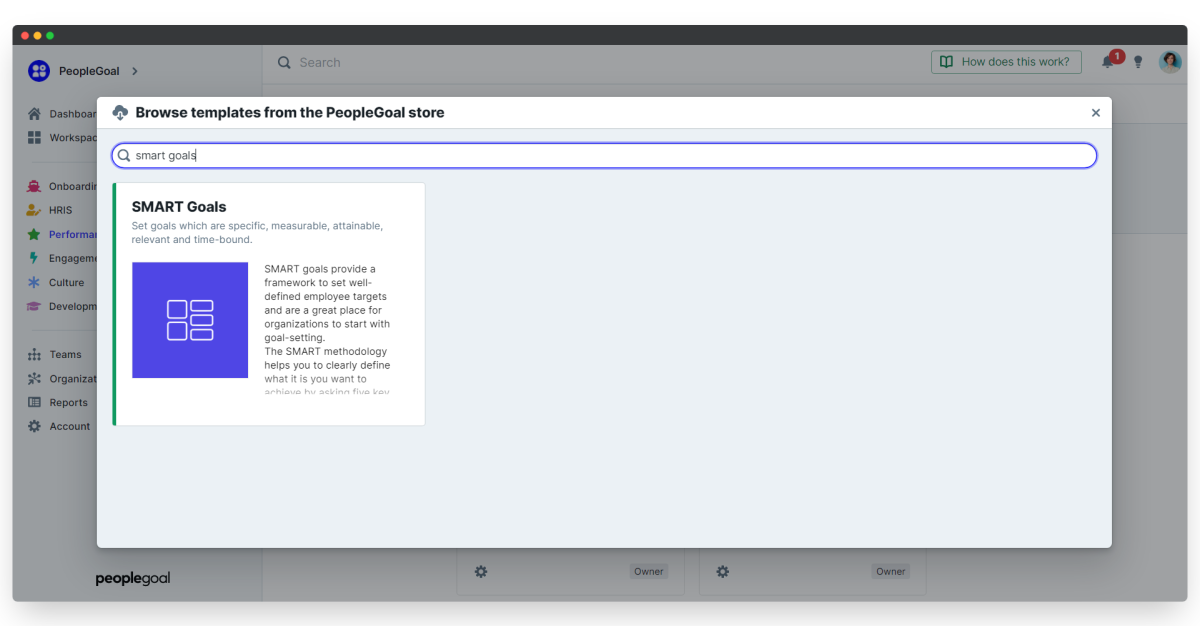

The template is pre-built with questions and states installed and ready for use. If you don't require any further customization then skip ahead to step 4.
2. Customize the SMART Goals app Template
Should you wish to configure the SMART Goals to add your own custom fields and states, click the Template menu tab, then Edit template. The template is currently set up with a text area to describe your goal, followed by each of the SMART Attributes and a read-only Goal Approval section.
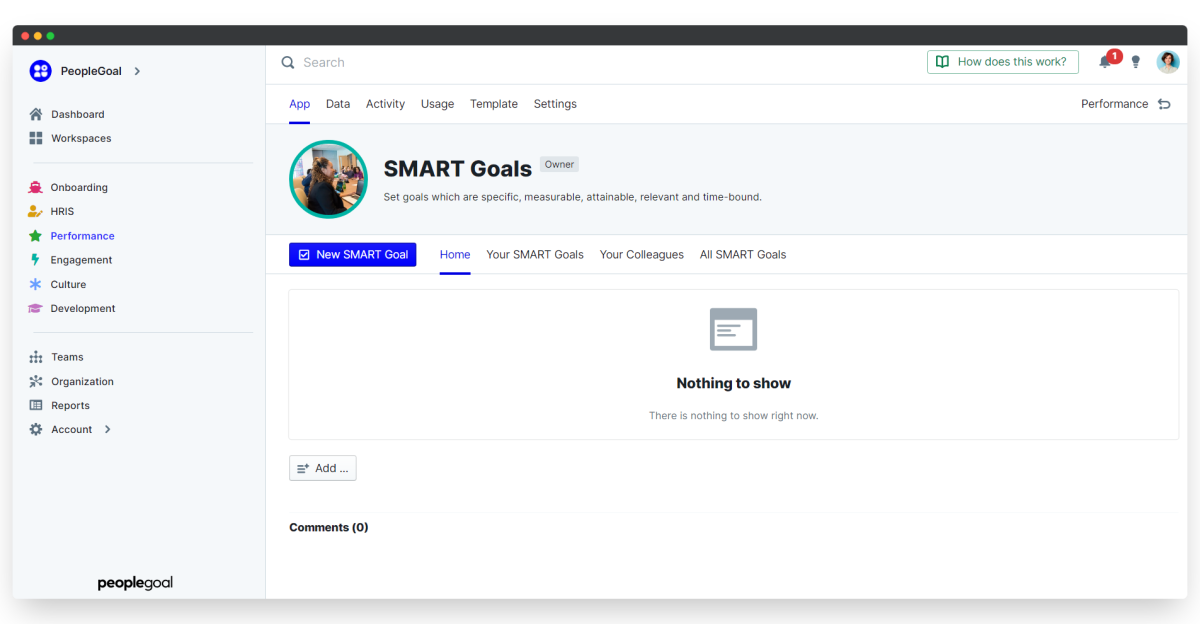
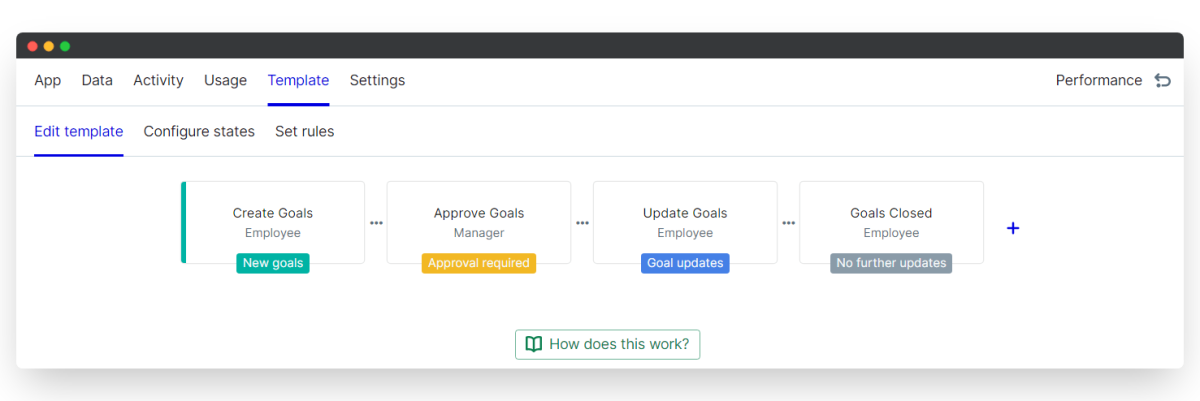
i. Edit existing elements
Elements are individual form fields that allow you to set your goals. You have the ability to change each element to suit your unique process and company culture. This might involved altering elements to be text questions, rating selects, display-only field or numerical calculations.
- To change a field, hover over the right-hand side of the element and click on the three dots that appear.
- Below Configure element, click Edit textarea (your element will have a name such as "Textarea", "Rich textarea", "Select" etc). This will open up the element editor.
- Customize the element however you like. You can alter the instructions, placeholder text, number of rows available and even the length of responses.
- Here you also have the ability to toggle whether employees are required to give a response or not.
- Be sure that after making all of your changes to select Save changes to update the element.
In this example, we change up the "Describe your goal in a few short sentences" field to have a different title and display text. Additionally, the size of the respondent's text area has been increased to enable a longer response.
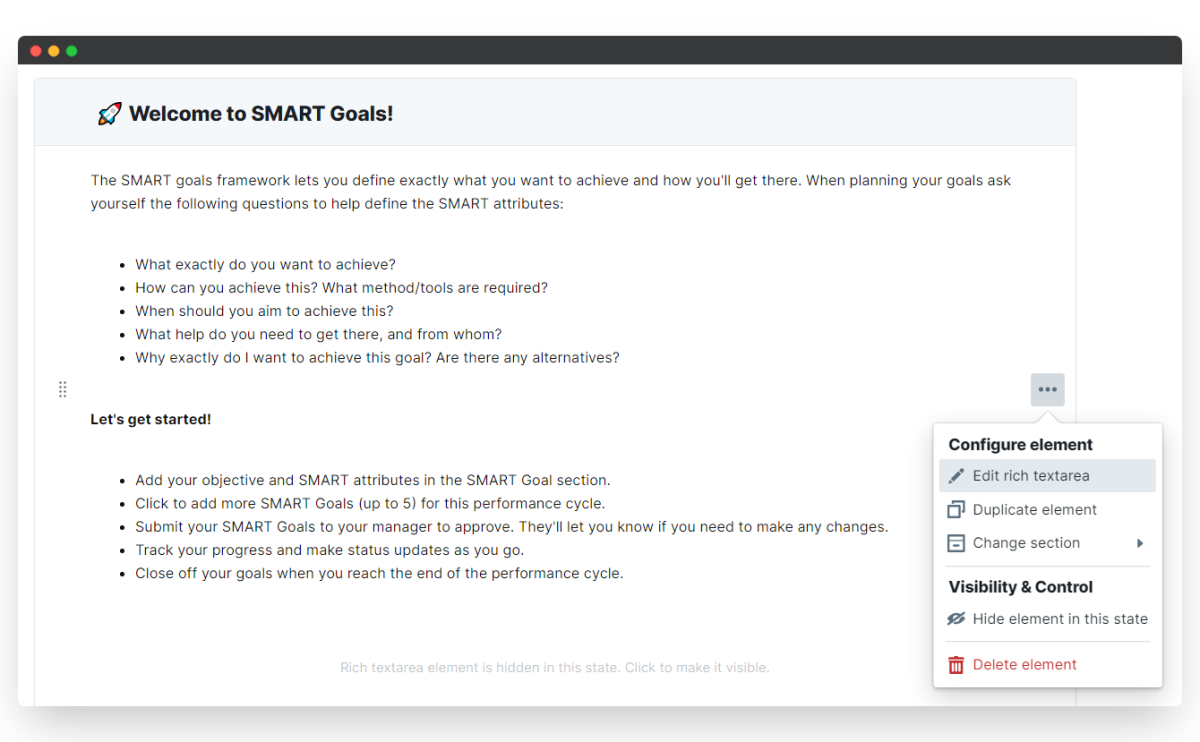
Note that any changes made are only applied to that specific element. This means that if you change the size of the respondent's text area, this will not affect other elements. If you want the altered text area to be set across multiple elements, there is an option to duplicate an element once you've got it set to how you want it.
ii. Duplicate elements
- Hover over the right-hand side of the element and click on the three dots that appear.
- Select Duplicate element and an exact copy will be created below.
- Edit the duplicated element to change your question text.
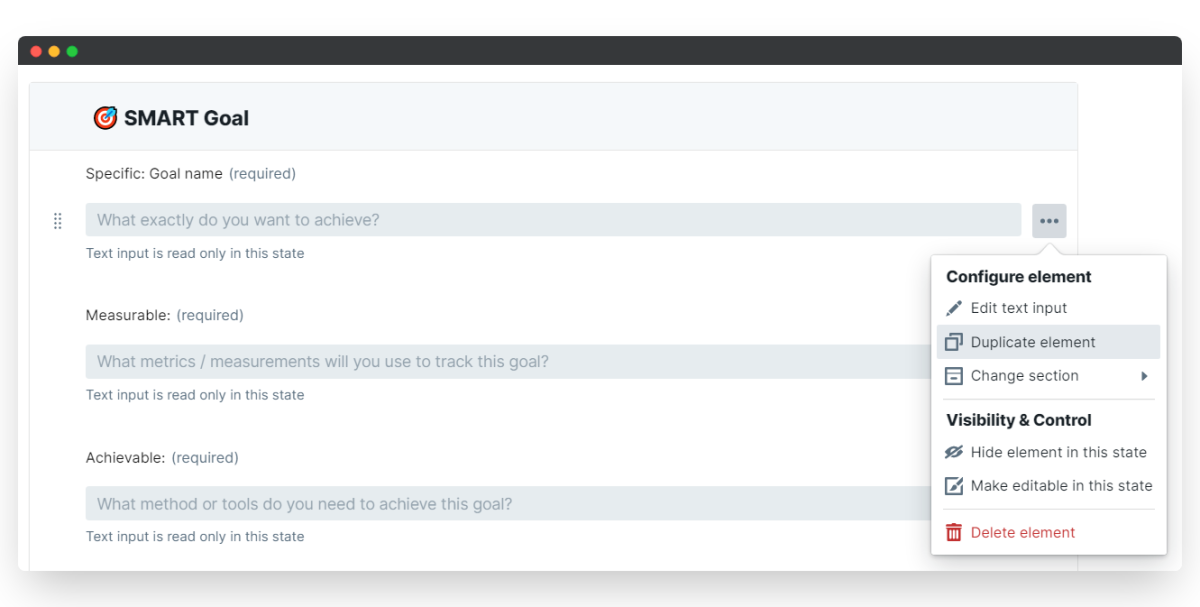
iii. Reorder elements and sections
Reordering is very straightforward - simply click and drag to change the element or section order.
- Hover over the left-hand side of the element (or section title) to click and drag your element or section to its new location.
- To move an element to a different section, hover over the right-hand side and click the three dots that appear.
- Select Change section and choose the new section you want the element to belong to.
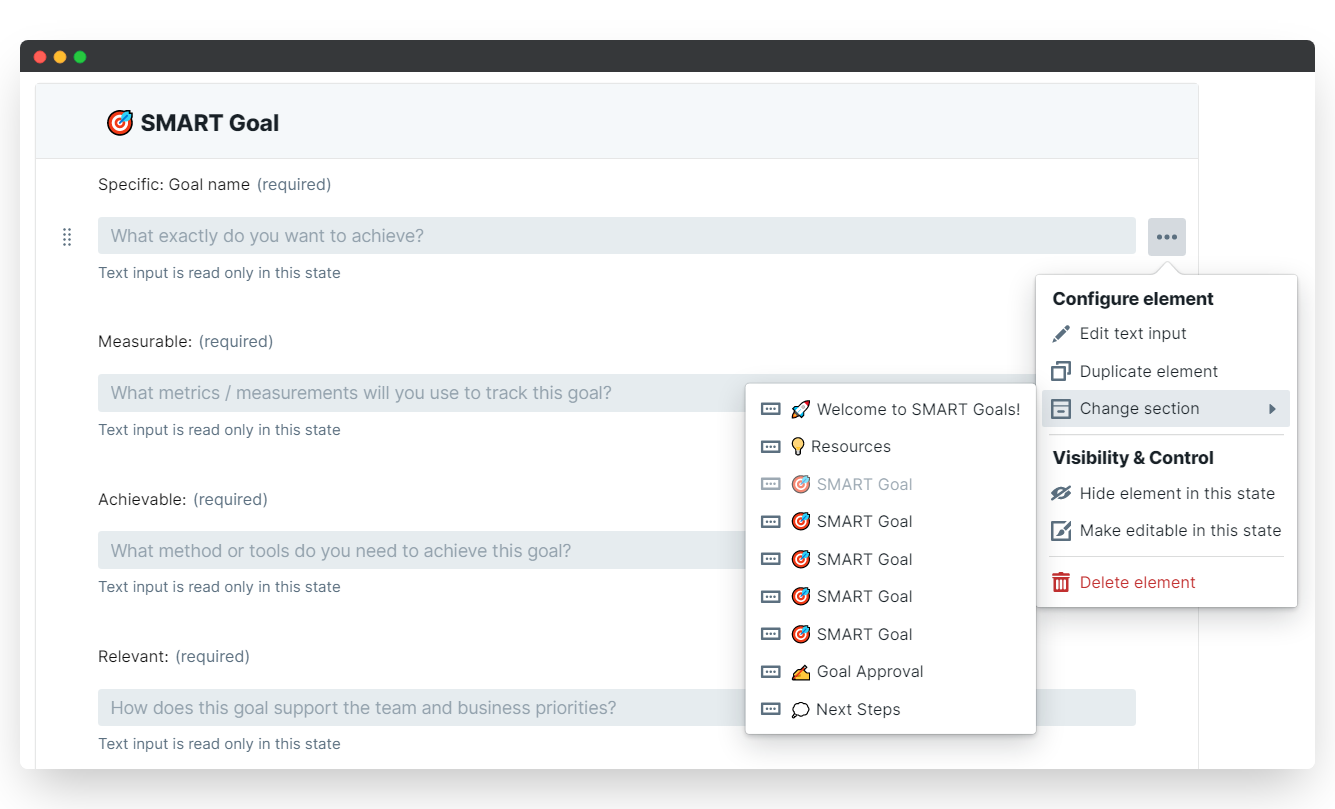
iv. Create new elements and sections
- At the bottom of each section, click Add element and select the element type you want to insert.
A new element that's useful to add to your first section is a display-only Description or Richtext area. For example, you can use this to inform employees and managers of the types of questions or desired results they should consider when setting their goals.
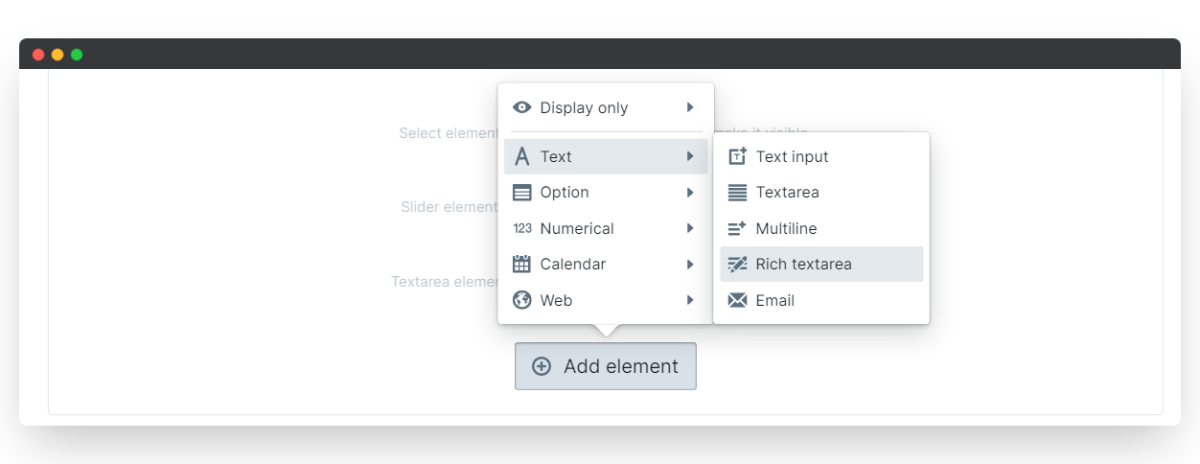
- To add a new section, scroll to the very bottom of your template form and click Add section.
- Then click and drag your new section to where you want it to sit in the survey flow.
In the example below, you can see we've added a new Personal Targets section with multiline options. This will prompt an employee to specify three personal targets that they should aim to complete in achieving the set goal.
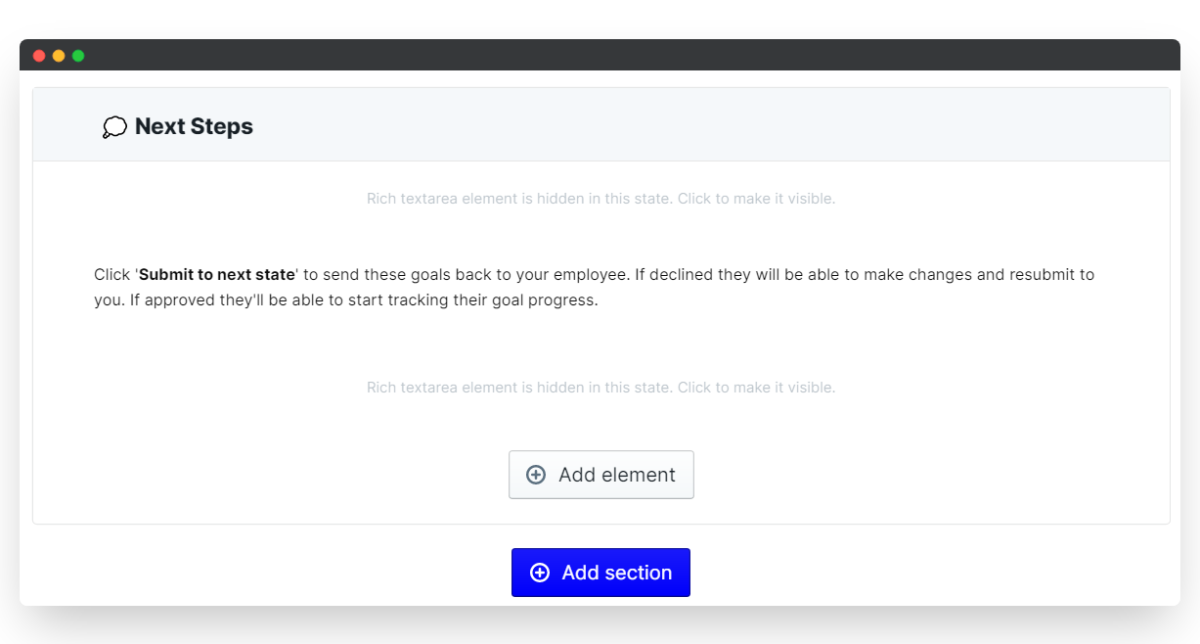
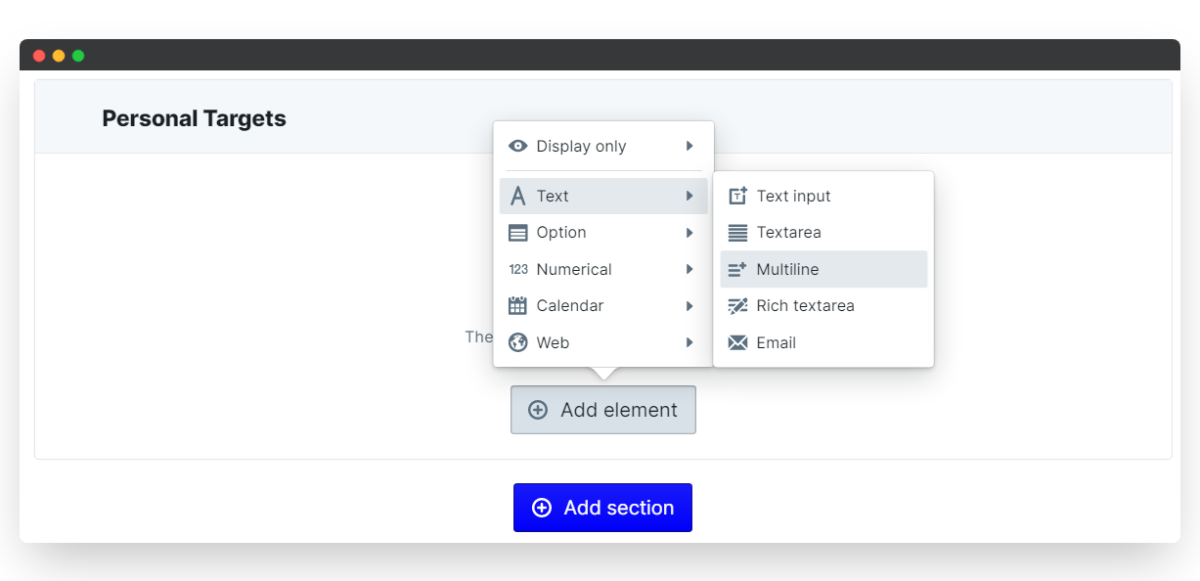
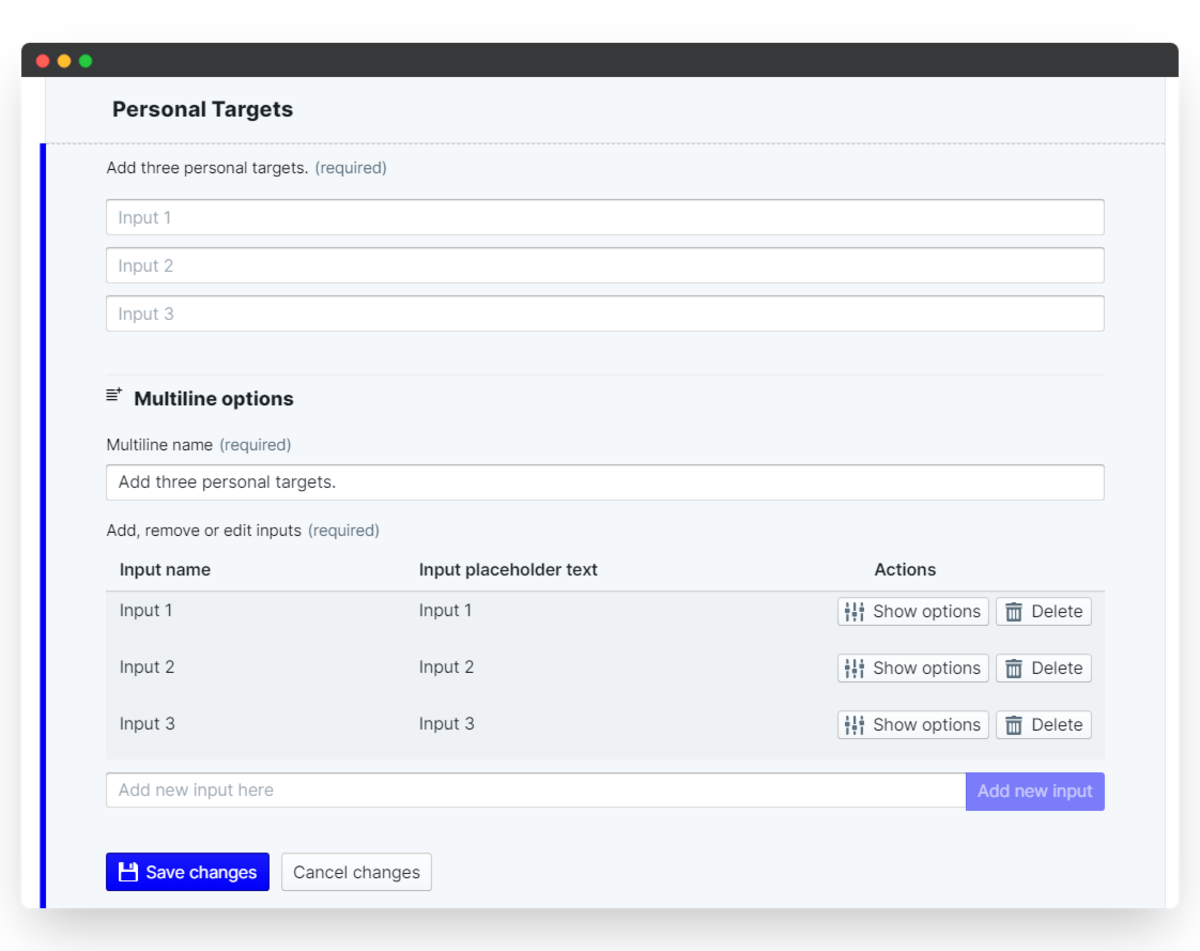
3. Connect to your team/company objectives
SMART Goals are designed for a certain employee to get clarity about the work they need to complete. Whilst each employee is set specific tasks, they are still contributing to the overall company objectives. By allowing employees to align their goals with wider objectives, this provides all involved with greater insights for tracking target completion. Make sure that you have the Company objectives app installed to connect these two apps.
- To connect to your company or team objectives, select the Template menu and click Edit template.
- Add an element in the Option menu called "Item select".
- Edit the name and placeholder text to suit your company language. Then in the search bar, type in the relevant apps that contain your objectives.
As demonstrated in the example you could search "Company Objectives" or "OKRs". Whatever options you enter in this box, will then become available for employees to select and connect with their SMART Goals.
- You may want to toggle off the requirement for this response to be given in this element.
- As always be sure to select Save changes when you're done.

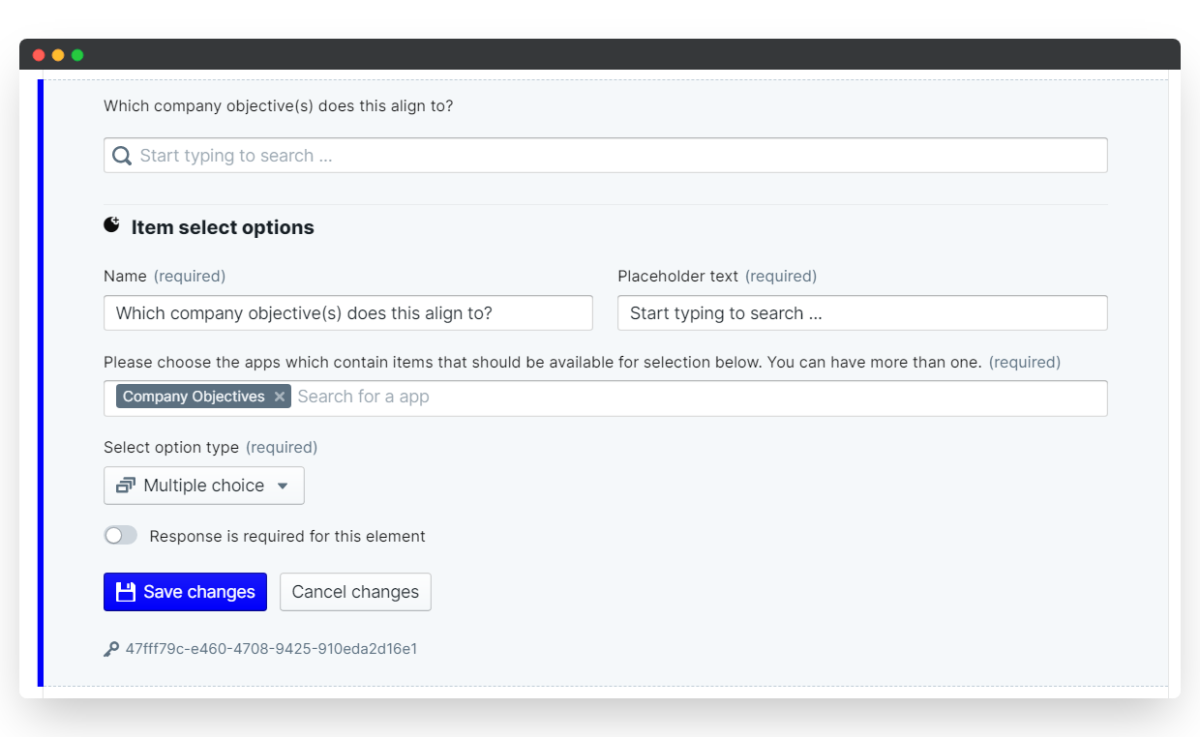
4. Configure the SMART Goals states
States are the steps in your SMART Goals workflow, and each state has its own participant. The employee is the participant in the "Create Goal" state, which represents one state. In the same way, the "Approve Goal" and "Update Goal" are states.
You can add as many states as you like to your SMART Goals workflow, which enables you to easily create a complex process where each stakeholder can participate. Additionally, it is possible to control the visibility of sections (and individual elements) in every state. These can be set to read-only, editable or hidden for the selected state participant.
i. Add a new state
- From the Edit template page, click the + button to create a new state.
- Type in your state name, define the participant role and choose a status flag.
- Next, toggle on/off whether sections are visible or editable by default (this can be changed at a later point if necessary).
- Click and drag your state to reorder your SMART Goals workflow and you're good to go!
In this example, we have created a state for a second Goal Approver. We've added a section for this state so that we can enable an additional manager or leader to verify the goals set by the employee. This way the goal cannot be approved until two independent leaders give their approval.
To do this, we created a new state, entered all of the relevant information and toggled the state so that all sections and elements are visible but not editable. Then we simply scrolled down to the pre-existing Goal Approval section and duplicated the element, before making the relevant elements editable.
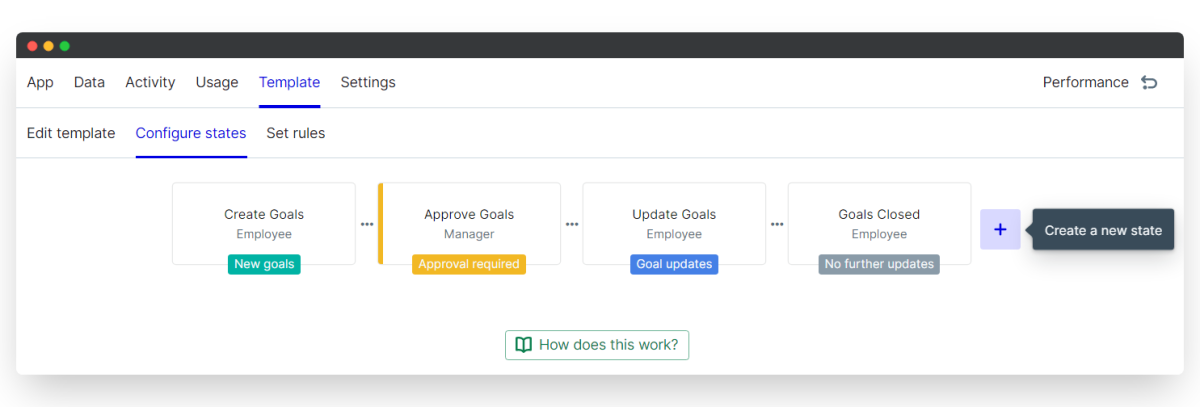
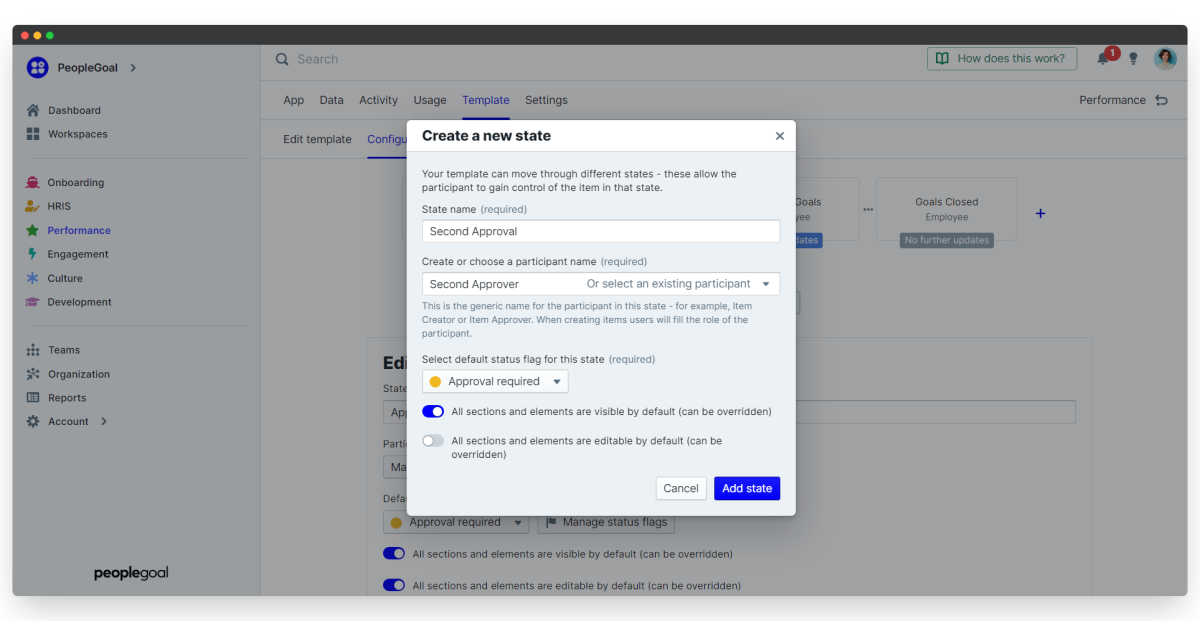


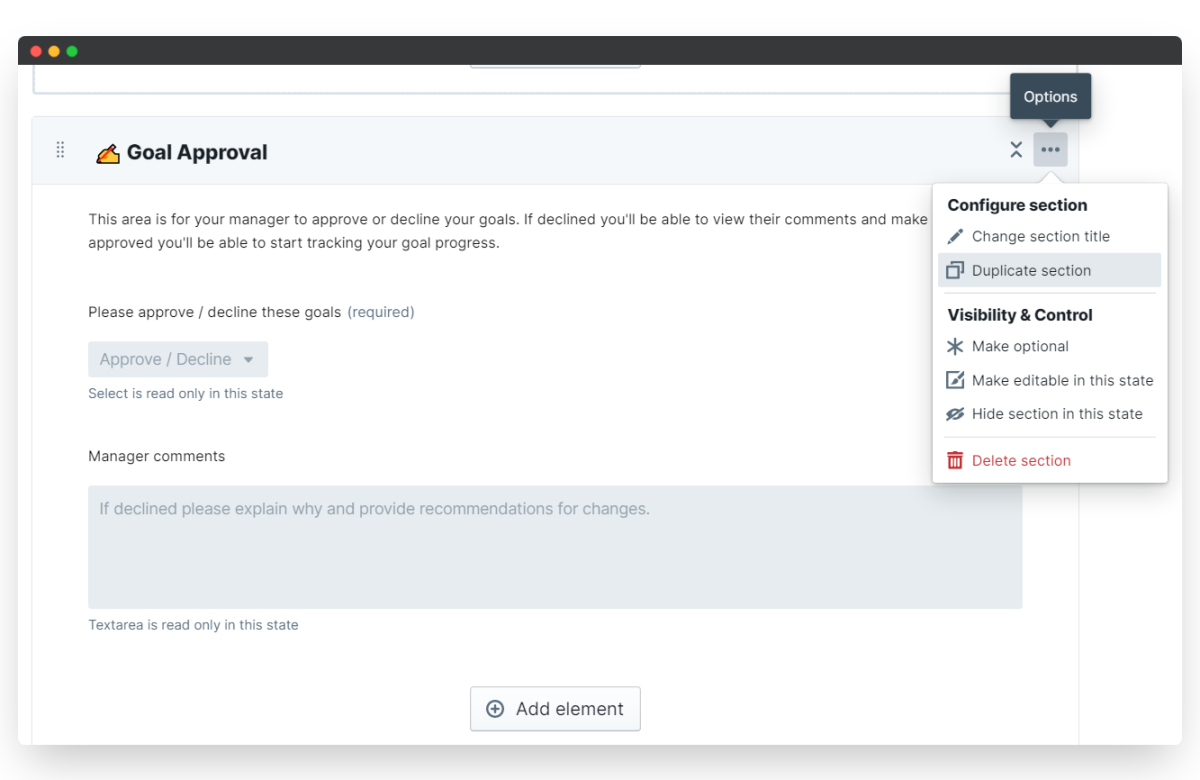

ii. Delete a state
You can remove any states that you do not need to use.
- Click the Template tab and select Configure states.
- Select the state you wish to delete and a blue highlight bar will appear, confirming which state you have selected.
- Click Delete state to remove it.
For this example, our team no longer needs two individuals to approve employee goal setting. As a result, we will delete the second Goal Approval state. Since we now only have one Goal Approver, we can delete the second Goal Approval section in the app template so that these questions do not appear in the workflow.
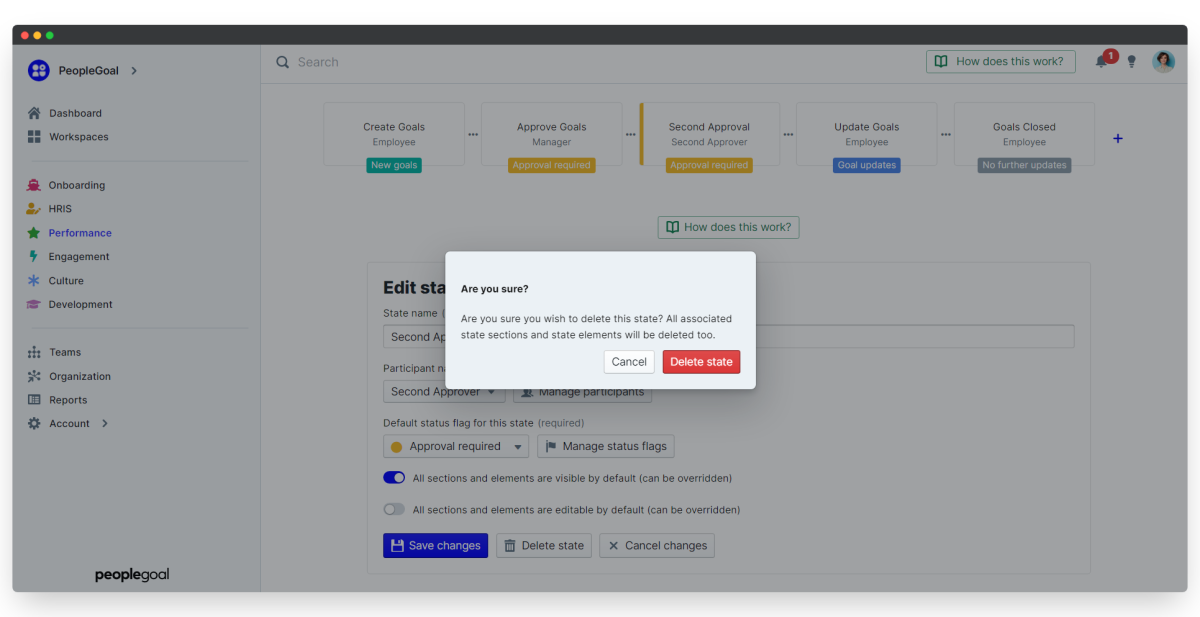
iii. Customize your status flags
Each state has a default status flag which indicates to participants what stage of the process their item is in. Your SMART Goals app is pre-built with default status flags, which you can alter.
- From the Configure states menu, click on Manage status flags.
- Click a flag title to rename it and click the color picker to choose a new flag color.
- Click Create a new status flag to add an additional flag.
- Select the state to which you want to assign a flag, choose which flag to give it and click Save changes to update.
It's advisable to delete status flags that are unused so that they don't clutter up your item filter once you start setting goals.

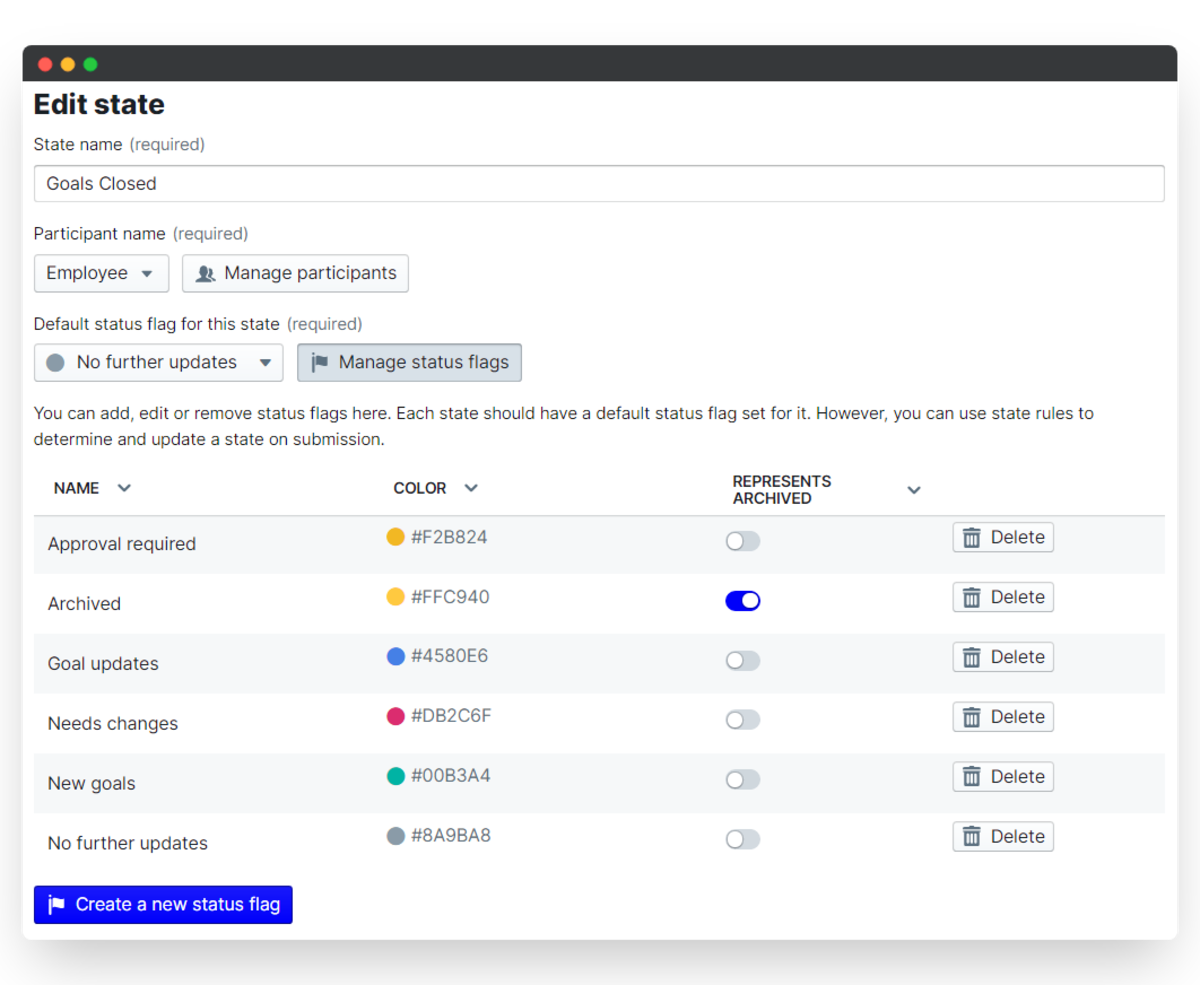
5. Manage your SMART Goals App participants
Participants are the individuals involved in the goal setting and each state has one participant. In setting SMART Goals, you can automate the process of selecting the necessary participant to approve the goals based on your account Relationships. Alternatively, you define an individual as the state participant, or leave this blank for the employee to select all participants in their review.
Setting up your participants based on relationships means that when an employee's SMART Goal is created, all of the people who need to be involved in the workflow are automatically assigned.
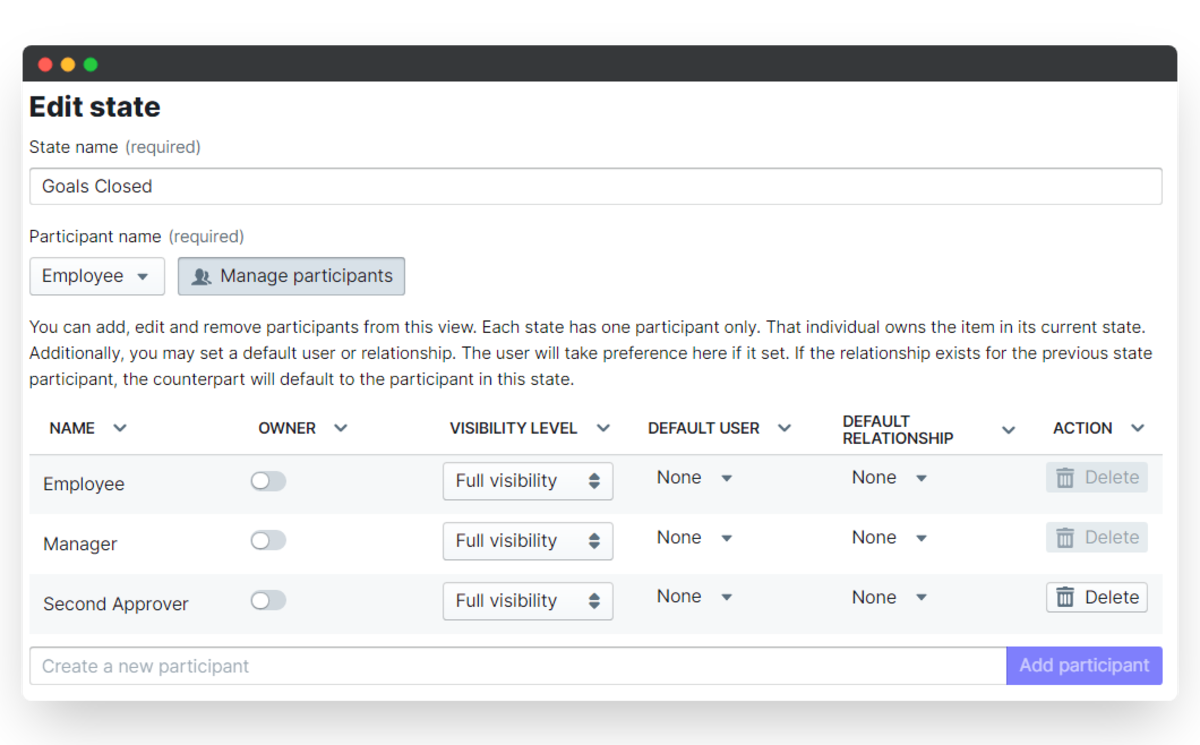
i. Set default relationships and users
- Open up the Configure states menu and select Manage participants.
- For the Goal Approver participant set a default user or default relationship to automate the SMART Goals workflow.
- You can also edit the name for participants to suit your own company language.
Below, you can see how we set the default relationship for the Goal Approver role to Manager.
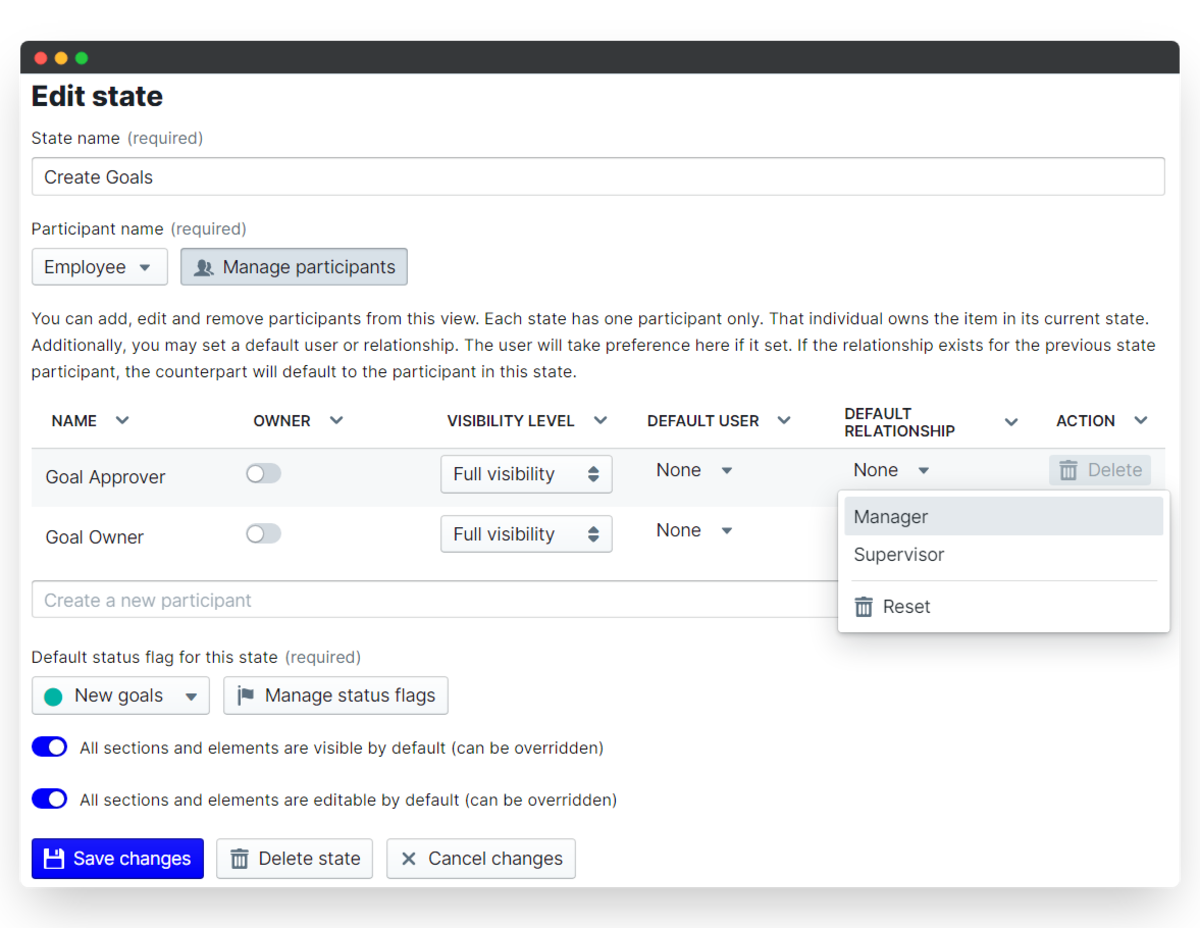
ii. Define the participant's visibility
Typically all involved in the process of goal setting should be able to see each step in the making of goals. This is how the template is set up as default - all participants are set to Full visibility. This means that participants can see the goal in progress even if they're not the participant who owns the current state.
Should for any reason you wish to make the comments of the Goal Approver hidden, then you can do this by simply changing the Goal Owner's visibility to Limited visibility.
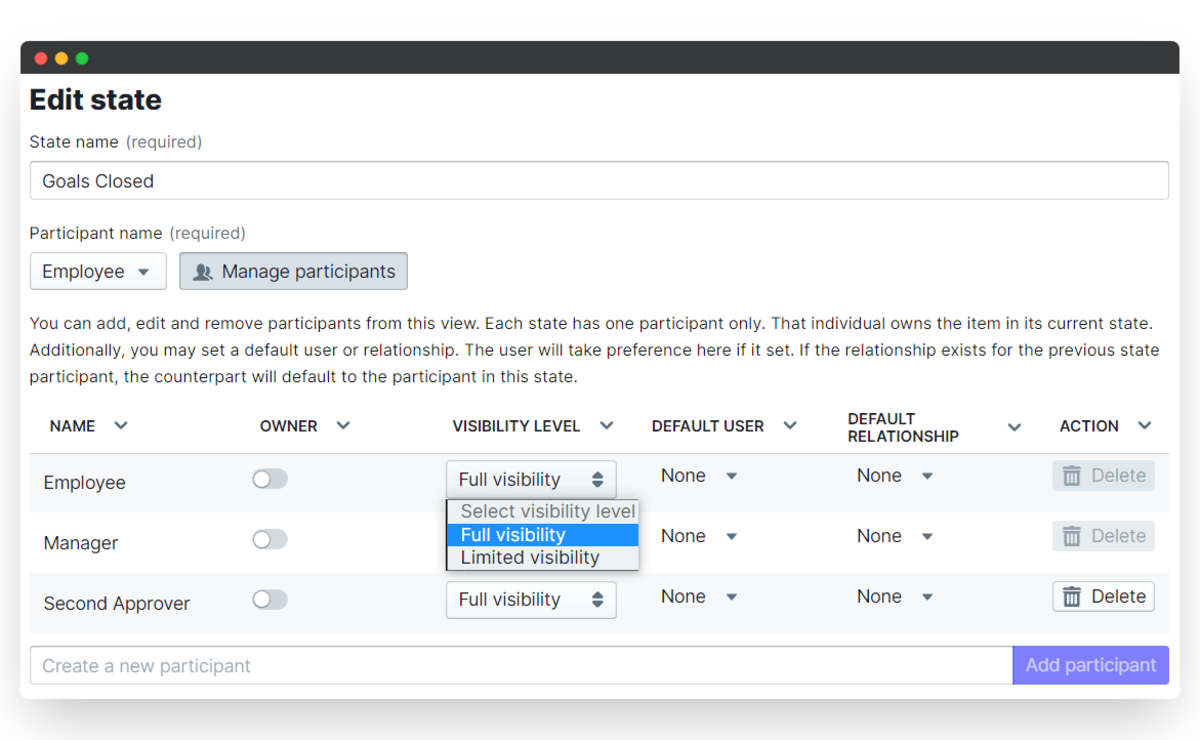
6. Set the SMART Goals App permissions
Permissions control access to your app within your PeopleGoal team. Different levels of access will determine to what extent users can create/edit their goals.
- You can set your permission by clicking on the Settings menu, then expanding the Permissions section.
- Click on Explain permission types to understand the access that each permission gives your account users.
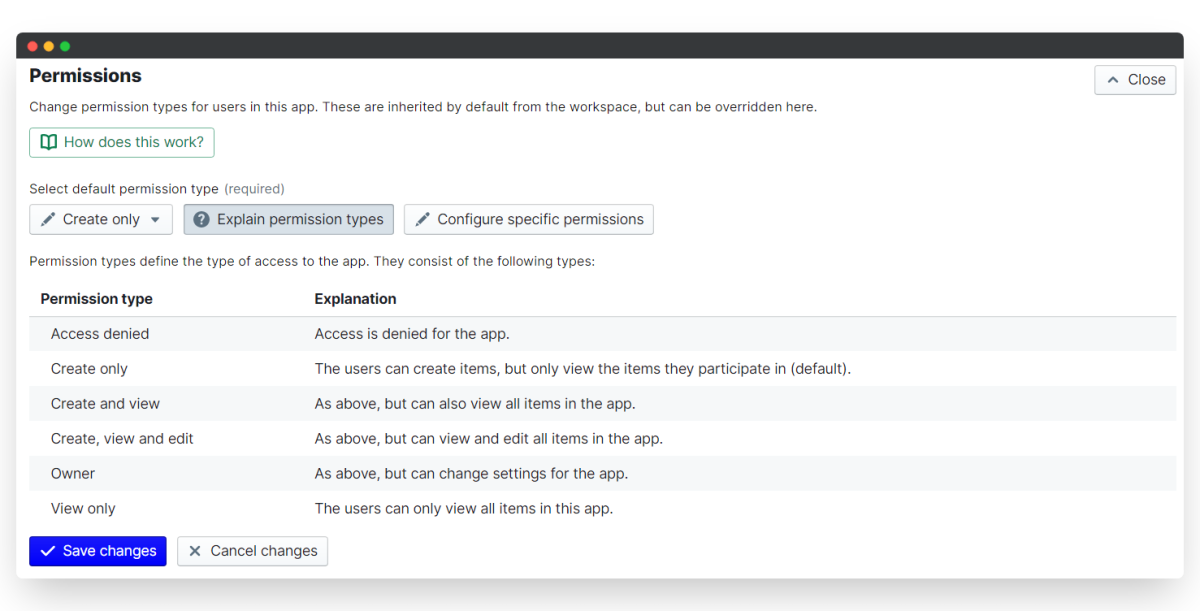
i. App-wide permissions
For SMART Goals we'd recommend you set the permission to "Create and view". This means employees can create goals for themselves and can also view what other team mates have been setting as goals.
ii. Relationship permissions
Separate from team and user permissions, you can set a relationship permission that automatically gives the superordinate access to create, view and edit the items just for their subordinate. This is especially useful in SMART Goals so that managers can create, view and edit goals for their direct reports.
- Under Relationship permissions, select your relationship type.
- The only permission available here is "Create, view and edit" so this will be automatically set.
- Click Save changes to update.
iii. Specific user permissions
The user who installed the Performance app template has Owner permission by default. App owners are different to account owners, so you can be an app owner without having access to any of the Account settings. Any specific team and user permissions supercede the default permission type.
- Assign a specific permission by selecting Configure specific permissions.
- Under "User permissions" click Add user.
- Type your colleague's name to add them to the permission list. In the "Permission type" column, select which permission level to give them.
iv. Specific team permissions
- If, for example, you have a specific team that you intend to grant permissions, then under "Team permissions" click Add team.
- Just as with "User permissions", type the team's name to add them to the permission list.
- In the "Permissions type" column, select which level to give them.
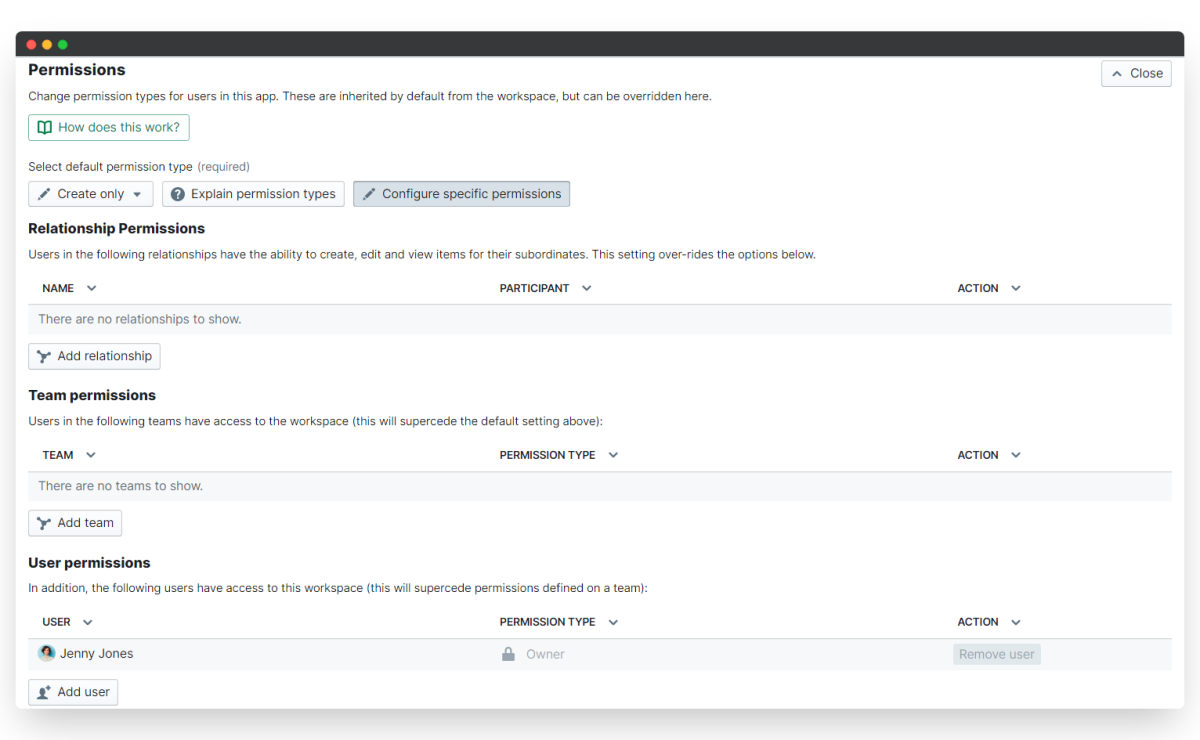
7. Launch your SMART Goals!
High five! You're now set to start getting your employee SMART Goals set. To do this you either need to create them for individuals or prompt them to create their own.
- For this, from the SMART Goals workspace click on New SMART Goal.
- To set a goal for yourself, select your own name.
- To create a goal for individuals, click Select user(s) and search for your specific employee names.
- Alternatively, click Select team(s) of users and you can introduce goals setting for entire user groups! What's more, you can select your Company team here to initiate goal setting for everyone in the account.

Next steps: set up your custom SMART goals analytics and reports
At PeopleGoal, we appreciate that every organization has its own unique culture and way of getting things done. Our software captures every single data point from your SMART Goals in the Data table, enabling you to build custome reports and automated charts. Check out our Reports building article to learn how to create your own custom reports and analytics tracking.
Having got your SMART Goals app up and running, come and take a look at our other apps that you can install within your Performance workspace. It might be particularly helpful for your goals setting to establish your Company Objectives, if you haven't done so already. You may also want to arrange some One-to-Ones with employees to gather insights and for establishing the individual's personal experiences of achieving their set goals. You can find all of these and more in our App Store.
Don't have a PeopleGoal account yet? Book a demo to see our no-code HR workflow builder in action!
PeopleGoal Support Team
Account Management & Implementation Specialists